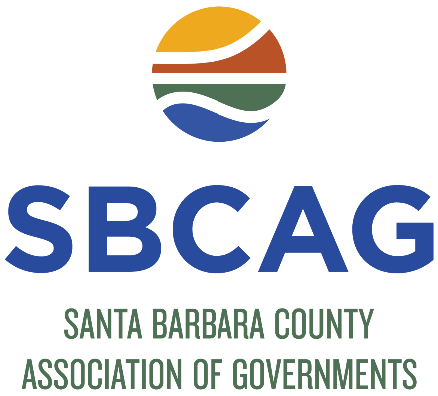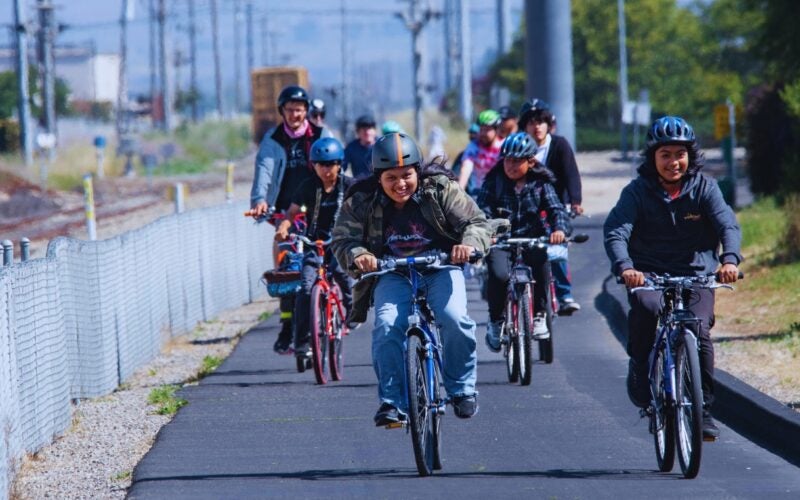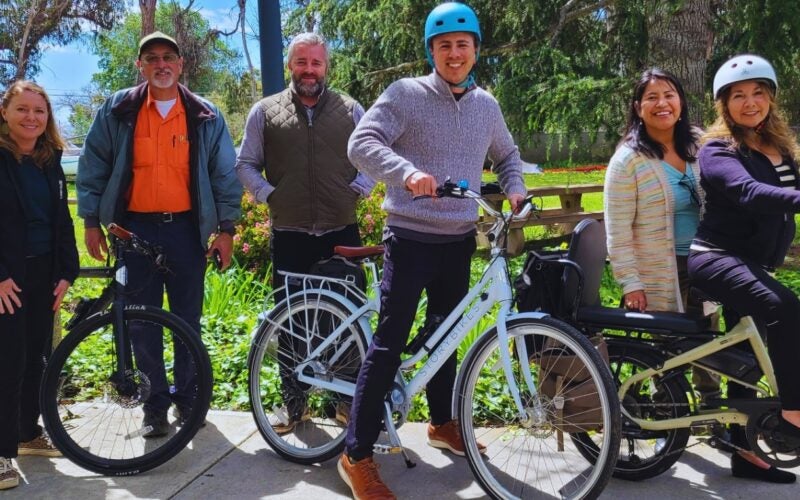Bike Santa Barbara County

The Happiest Commuters Bike to Work
Log bike commutes with SmartRide to earn rewards (SmartRide app available for Android and Apple devices). Local surveys show that bike commuters are twice as satisfied with their commute compared to other modes.
Bike infrastructure improvements and related programming are made possible by the Measure A local sales tax. Learn more here.
Bike Map
Our region’s last print bike map was released in 2013. A draft update is below. We recommend using this map to compliment trip planning from Google Maps. For those unfamiliar with Google Maps, here are tips:
Search for directions.
Select the cycling icon above the search bar.
Select a recommended route.
Use the map below to consider parallel bike infrastructure.
Return to Google maps and drag the route lines on the map to create a custom route.
Use the ‘person icon’ at the bottom-right of the screen to Street View the route and manage your expectations.
If you click lines on the map below, you may see a rating system of Easy, Medium, and Challenging. Please use this map for reference and understand that it contains duplicate lines. We are working toward a map update by 2026 (more details below map).
SBCAG, in partnership with University of California Santa Barbara, and Simon Fraser University (SFU), was awarded a $480,000 Sustainable Transportation Planning Grant from Caltrans to create an artificial intelligence (AI)-powered map of the county’s bicycle infrastructure. The project will provide the public with easy-to-understand and accurate information to find safe and connected cycling routes. Here’s how it might work:
- Student, advocate, and general community feedback can weight levels of safety and comfort identified in Street View images.
- This data will inform Ai, which will then translate Street Views countywide into a map with comfort levels (example: Easy, Medium, Challenging).
- Routinely updated datasets may be added, allowing Ai to increase/decrease comfort based on traffic volume, number of lanes, speed limit, elevation change, historic crash data, and more.
- We will do small print runs on a routine basis with the latest addition from this Ai output.
You are invited to participate in this project.
Register Bike – Prevent Theft
A stolen bike means less bike trips! Here are tips to prevent theft:
Lock It Up
- Spend $150 and consider high-security brands like ABUS, Otto, or Kryptonite New York
- Use multiple locks
- Use a cable to lock in your wheels with your primary lock
- Buy lockable skewers and seat post
- Park in a visible area
- Always lock your bike, even when parking inside
Register
It’s free to register an owned or stolen bike with your email, serial number, and a photo of the bike.
You are 5x more likely to recover a registered stolen bike. Whether stolen in Arizona or Santa Barbara, law enforcement can link you to a recovered bike. Here are the steps to register:
- Visit the Bike Index to report a stolen bike.
- Keep an eye on Craiglist and contact local pawn shops within our tri-county area.
- Your homeowner or renter’s insurance may cover replacement cost.
Visit any local bike shop or contact SBCAG for a unique QR-code registration sticker that increases visibility to would-be-thieves and law enforcement.
Bikeshare for Work with EZ Bike Project
SBCAG offers employers a chance to borrow a fleet of e-bikes for up to a month. During this time, employees can try e-bikes in a no-sales environment for both personal and work errands, for commuting, and for riding as a group to build workplace culture. Participants must complete an online registration/waiver form.
SBCAG will occasionally offer community opportunities to try out a variety of e-bikes. Subscribe to our newsletter list to be among the first to learn of these opportunities.
Bike Month – CycleMAYnia
May is National Bike Month, branded locally as “CycleMAYnia.” Dozens of local organizations and volunteers work together to deliver a spectrum of activities and giveaways to encourage more trips by bicycle.
California E-Bike Subsidy
The California E-Bike Subsidy Website is Live! Once launched, the state of California will pay between $1,750 and $2,000 for an electric assist bicycle, cargo e-bike, or adaptive e-bike. You qualify if you have an annual income less than:
- Individual: $43,740
- 2-person: $59,160
- 3-person: $74,5804-person: $90,000
- 5-person: $105,420
Hazard and Crash Reporting
If you have a near-miss, fall, hazard, or theft to report to the cycling community, please visit: BikeMaps.org, a project of UC Santa Barbara.
Specific hazards should also be reported by location:
- City of Buellton – (805) 688-5177
- City of Carpinteria – submit a mapped service request
- City of Goleta – (805) 968-6769
- City of Lompoc – (805) 875-8021
- City of Santa Barbara – (805) 897-2630
- City of Santa Maria – (805) 925-0951, ext. 2229
- City of Solvang – (805) 688-5575, ext. 228
- Santa Barbara County Roads – (805) 681-5678
- Caltrans State Highway System (101, 246, 1, 154) – (805) 549-3318
- UC Santa Barbara – (805) 893-8300
Bike Parking
SBCAG has identified more than 1,264 bike parking spaces and 98 bike lockers in Santa Barbara County. Contact us if you want to know before you go. You can access public bike lockers by contacting the following agencies:
- Goleta Amtrak, Santa Barbara Amtrak, Carpinteria Amtrak, and Orcutt (west) Park & Ride – (805) 963-7283
- City of Buellton – (805) 688-7474
- The Bike Spot at SB MTD Transit Center and Anacapa at Anapamu
Shops, Clubs, Organizations List
SBCAG provides Santa Barbara County bike shops with free bike maps and registration stickers.
Santa Maria
Santa Ynez Valley Area
Goleta and Isla Vista Area
Santa Barbara
- Bici Centro Santa Barbara*
- Bici Centro City College* – east campus
- Energized Bikes Mobile Bike Repair
- e-Bikery
- Electric Bikes of Santa Barbara
- Fastrack
- Hazard’s Cyclesport
- Open Air Bicycles
- REI
- Stape Cycles
- Velo Pro
Montecito and Carpinteria
- Mad Dogs & Englishmen Bike Shop, Montecito
- Bikesmiths – (805) 684-3150
- Carp Sports
- Gonzo Cycles – (805) 242-2554
*MOVE Santa Barbara County is home to three Bici Centro locations, which are community workshops and bike thrift stores. For ~$5/hour, you’ll have tools and instructors necessary to maintain your ride. MOVE also provides advocacy, education, and outreach that improve mobility options in Santa Barbara County.
Known clubs in Santa Barbara County include:
Commute Tips
Getting Started
- Move your bike from the back of the garage to the front of the garage (remove barriers that keep you from biking to work)!
- Make sure you have the necessary equipment. Low-cost bike helmets are available through the Santa Barbara County Public Health Department.
- Get more tips from The League of American Bicyclists.
Bus – Load/Unload
- Load from curb side of bus
- Squeeze handle to release the folded rack
- Use the innermost slot available
- Load front wheel on side labeled “front” and pull and raise the support arm over tire
- Alert driver and exit from front of bus
- Raise and drop the support arm to remove the bike
- Fold up rack if no other bike is present
E-Bike Safety
The California Highway Patrol and People for Bikes have developed safety curriculum we recommend for e-bike users. Here are some tips:
- ABC Quick Check (air, brakes, chain, crank)
- Fill to max PSI shown on your tire
- Check that your quick release levers are closed
- Adjust and replace brakes regularly since e-bike brakes wear out quickly
- Apply 70% front and 30% back when braking
- Brake levers should stop short of handlebar when pulled
- Lube chain if it looks dry
- Check crank for rattling by moving a pedal back and forth
- Farther by Bus/Rail
- Consider e-bike weight and tire size if purchasing an e-bike you plan to use on the bus or train
- Learn how to use your bus’s bike rack
- Make sure you are comfortable lifting your bike onto racks or into luggage bins (coach buses)
- Buy a folding e-bike if you know rack or luggage bin are in high demand on your route
- Folding bicycles (34” X 15” X 48” or smaller) are allowed onboard all trains as carry-on baggage.
- Most Amtrak® Pacific Surfliner® trains are equipped with six bike racks located in the “cab car,” available by reservation only (reservations not available on some trips or on connecting buses)
- Passengers traveling on Amtrak Coast Starlight® trains 11 and 14 or connecting to the Southwest Chief® or Sunset Limited® in Los Angeles will be required to check the bike in a bicycle box, available for purchase for $10.00.
- For Amtrak assistance call: 1-800-USA-RAIL or visit Amtrak.com/baggage-policy.
- Ask an E-Bike Guru
- Learn about watts, volts, amp hours, and Newton meters of torque to make sure you buy an e-bike with enough power.
- If you are replacing your car, consider a mid-drive e-bike.
- Buying an e-bike with a hub motor will save money.
- There are more than 225 brands of e-bikes, including models that fold, are lightweight, carry cargo, or go faster.
- Crash Considerations
- Care for injuries
- Take photos or note details (vehicle color, make model, driver description, damage)
- Do not negotiate with the driver
- Document contact and insurance information while waiting for the police
- File a police report
- Save receipts for all medical and repair expenses
- Select Your Class
- Class 1 is pedal assist up to 20mph
- Class 2 has a throttle assist up to 20mph
- Class 3 is pedal assist up to 28mph. A helmet is required. Class 3 e-bikes are typically not allowed on paths or in bike lanes.
- Time Your Pass
- Look for cars when passing by another person biking
- Take the lane when passing a right-turning vehicle. Drivers will not expect your e-bike’s speed.
- Do not pass in an intersection
- Carry Passengers Safely
- Passengers under 18 must wear a helmet
- Do not carry passengers on a class 3 e-bike
- Do not exceed your e-bike’s weight limit with passengers
- Do not try to carry passengers without a passenger seat
- Balance your Load
- You must have one hand on the handlebar
- Look up the weight limit for your bike rack and do not exceed it
- Buy two panniers if you regularly carry gear or groceries
- A class 2 e-bike (with throttle) can make it easier to carry heavy loads
- Charge It Up
- It takes between 2 and 7 hours to charge most e-bikes
- Charge your e-bike to roughly 60% for long-term storage
- Use the charger that came with your e-bike to prevent a battery fire
- Buy a fire extinguisher rated for lithium
- Avoid purchasing e-bikes priced under $800. The largest issue around bad batteries stem from the US de minimis import clause, which allows any imported products priced under $800 entry into the country without requiring any taxation or inspection.
Riding Tips
Plan your trip using the bike map resource on this page. Route within your equipment or personal abilities (5 miles on an acoustic bike or up to 90 miles on certain e-bikes). Pedal more and throttle less to increase your range on an e-bike.
Dress the Part
Avoid dangling items, like hoodie ties. Wear flat-heel shoes, reflective items, and bright/comfortable clothes.
Finger Helmet Rule
Use two parallel fingers to space the top of your brown to the bottom of your helmet. Make those fingers into a “V” shape at the base of your ear and adjust straps to match. Use one finger to space the helmet strap and your chin.
Street Skills 101
Practice quick turns, avoiding obstacles, and different positions on your bike.
Ride with Traffic
Always ride in the same direction as traffic. Motorists and other road users are not looking for bicyclists to ride on the wrong side of the road.
Use Hand Signals
Signal to other drivers. Hand signals tell everyone what you intend to do: turn left, turn right or stop.
Be Predictable
Obey traffic signs and signals. Stay on a steady, predictable course as if driving a car. Don’t weave in and out of parked cars because motorists may not see you when you move back into traffic.
Intersections and Lane Positioning
If you are turning, watch for cars, signal and merge carefully to the center of the turn lane. Make your turn occupying the same space an automobile would. If you are going straight, stay in the rightmost through lane.
Get Visible
State Law requires bikes to have a front light visible from 300 ft., a back reflector visible from 500 ft. and pedal and side reflectors. A red flashing rear light and wearing light colored or reflective clothing further increasing visibility.
Watch for Car Doors
When riding along a street with parked cars, leave approximately 3-4 feet between you and the parked cars. The law does not require you to stay to the right or to ride in a bike lane if it is hazardous to do so.
Avoid Road Hazards
Look farther down the street to anticipate changes in the road; try to avoid potholes, drain grates and other hazards. Cross railroad tracks at a right angle.
Stay off Sidewalks and Yield to Pedestrians
Sidewalks are designed for walking. Sidewalk riding is a leading cause of bike crashes and makes you less visible to motorists.
Don’t Pass on the Right
Many crashes occur when cars turn right into the path of a bicyclist. This can be avoided by moving out of the right-hand turn lane when you are proceeding straight.
Share the Trail
Alert others when passing by using your voice or a bell. Watch your speed when sharing the path since dogs and children are unpredictable. Slow down and look both ways when the trail crosses roads or driveways.
Roundabouts
Take the lane and ride with traffic. While roundabouts don’t have striped bike lanes, traffic moves slowly, allowing bicyclists and motorists to share space. Bicyclists have the same rights and responsibilities as motorists while in the roundabout.
Laws
This is a summary of the bicycle provisions of the California Vehicle Code.
Disclaimer: This list is not exclusive of all changes in the Vehicle Code. Please refer to www.dmv.ca.gov for accuracy of information.
- § 21200. Bicycle riders have all the rights and responsibilities of vehicle drivers.
- § 21200.5. It is against the law to ride a bicycle while under the influence of alcohol or drugs.
- § 21201. Bicycles must be equipped with a brake capable of making a one-wheel skid on dry, level pavement. Handlebars must not be higher than the rider’s shoulders. The bicycle must be small enough for the rider to stop, support it with a foot on the ground, and restart safely. Every bicycle operated at night must have the following equipment:
- A white headlight, or a white light attached to the rider and visible from the front from 300 feet.
- A red rear reflector visible from 500 feet
- White or yellow reflectors on each pedal, shoe or ankle
- A white or yellow side reflector on the front portion of the bicycle and a white or red reflector on the rear portion of the bicycle, or reflectorized tires
- § 21202. Bicyclists traveling slower than the normal speed of traffic must ride as close to the right as practicable, except in the following situations:
- When passing another bicycle or vehicle
- When preparing for a left turn
- To avoid hazards that make it unsafe to stay far to the right (e.g. a parked car door opening or substandard width lanes)
- On one-way streets, bicyclists may ride as near the left as practicable.
- § 21203. Bicyclists may not hitch rides on vehicles.
- § 21204. Bicycles must have a permanent and regular seat unless designed by the manufacturer to be ridden without one. Passengers must have a separate seat, and passengers 4 years old or younger, or weighing 40 pounds or less, must have protection from moving parts and wear a helmet meeting Snell or ANSI standards.
- § 21205. Bicyclists may not carry any package or article that prevents them from keeping at least one hand on the handlebars.
- § 21210. It is illegal to leave a bicycle on its side on a sidewalk or park it in any way that blocks pedestrians.
- § 21212. All bicyclists younger than 18 years old must wear a properly fitted and fastened bicycle helmet that meets Snell or ANSI standards when operating a bicycle.
- § 21650. Bicyclists may ride on the shoulder of a roadway unless it is specifically prohibited.
- § 21650.1. Bicyclists on the shoulder must ride in the same direction as traffic on the roadway.
- § 21960. Bicyclists may not ride on freeways where signs prohibit it.
- § 23330. Bicyclists may not cross a toll bridge unless permitted by signs.
- § 27400. Bicyclists may not wear earplugs in both ears or a headset covering both ears. This section does not apply to hearing aids.
Help for Bike Commuting
We can help you route to work, find someone to ride with, and learn about e-bikes.
"*" indicates required fields








